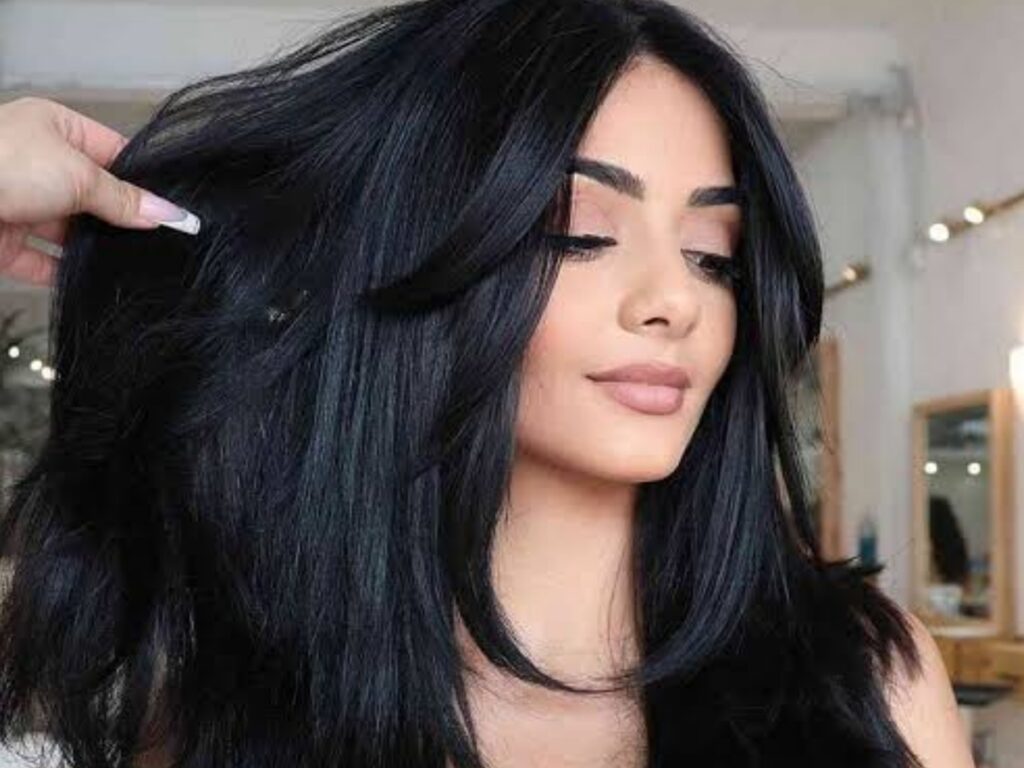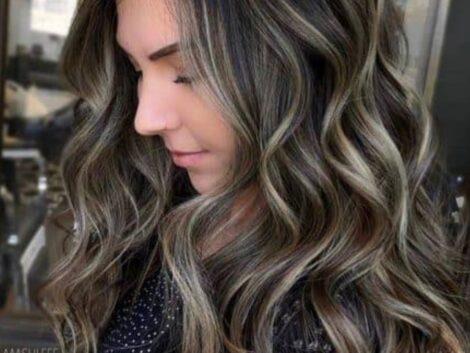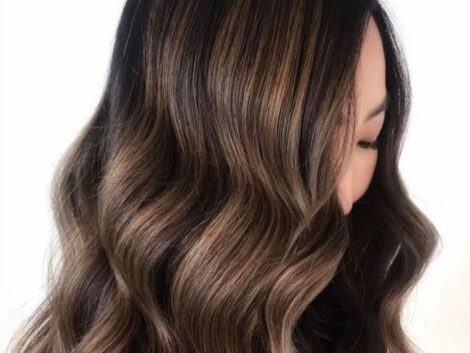Balayage is a versatile hair coloring technique that can work beautifully with black hair, adding dimension and depth to your locks. When considering balayage options for black hair, choosing shades that will complement your natural color and skin tone is important.
For a subtle contrast, warm tones like caramel or chestnut can be an excellent choice. These shades create a sun-kissed effect, blending harmoniously with the rich black base. This approach is ideal for those who want a natural and low-maintenance look.
On the other hand, if you’re looking for a more striking and dramatic change, consider opting for vibrant shades like burgundy or dark violet. These bold colors can create a stunning contrast against your black hair, making a strong fashion statement.
When choosing the right balayage for your black hair, it’s recommended to consult with a professional colorist. They can assess your hair’s condition, skin tone, and personal preferences to determine the best shades and techniques for you. Remember that proper aftercare, including using sulfate-free shampoos and regular conditioning, will help maintain the vibrancy and health of your newly balayaged hair.
What is the best balayage color for dark hair?
The best balayage color for dark hair depends on your desired look and skin tone. For a natural and subtle effect, warm tones like caramel, honey, or chestnut can work well, creating a sun-kissed appearance. These shades blend beautifully with dark hair, adding dimension without drastic contrast.
If you’re looking for a more noticeable change, cooler tones like ash brown or icy blonde can provide a striking contrast against dark hair, creating a bold and modern look.
For those who want a trendy and unique style, unconventional shades like rose gold, violet, or even deep blue can add a dramatic and creative touch to dark hair.
Ultimately, the best balayage color will be one that complements your skin tone and suits your style. Consulting with a professional colorist can help you make an informed decision based on your hair’s condition, your preferences, and the overall look you’re aiming for.

What highlight is best for black hair?
When choosing highlights for black hair, it’s important to consider your skin tone and the level of contrast you desire. Here are some options to consider:
- Caramel Highlights: These warm-toned highlights create a subtle and natural look, adding dimension without being too stark against black hair.
- Honey or Golden Highlights: These shades can provide a warm and sun-kissed effect, enhancing the natural beauty of black hair.
- Auburn Highlights: Adding reddish undertones can create a beautiful contrast and give your black hair a vibrant twist.
- Burgundy Highlights: For a more dramatic look, burgundy highlights can add depth and intensity to your black hair.
- Ash Brown Highlights: If you’re looking for a cooler option, ash brown highlights can provide a modern and sophisticated contrast to your black hair.
- Platinum Blonde Highlights: For a bold and high-contrast look, platinum blonde highlights can create a striking effect against black hair.
Remember, the best highlight color for black hair depends on your style, skin tone, and the level of contrast you’re comfortable with. Consult with a professional colorist to determine the shades that will suit you best and maintain the health of your hair throughout the highlighting process.
What is the difference between partial balayage and full balayage on black hair?
The primary difference between partial balayage and full balayage lies in the amount of hair that is highlighted and the overall coverage achieved:
- Partial Balayage: Partial balayage involves highlighting only specific sections of your hair. This technique is ideal for adding subtle dimension and brightness to your hair without completely altering its overall color. For black hair, partial balayage can be used to create a natural, sun-kissed effect by placing highlights strategically around the face and on select strands.
- Full Balayage: Full balayage, as the name suggests, involves highlighting a larger portion of your hair. This technique covers more sections of your hair, creating a more noticeable contrast and a bolder look. With black hair, a full balayage can add significant dimension and depth, creating a striking visual effect.
The choice between partial and full balayage depends on your preferences and the level of change you’re seeking. Partial balayage is a great option for a subtle transformation, while full balayage is better suited for those who want a more dramatic change or a stronger contrast against their natural black hair color. Consulting with a professional colorist can help you determine which option will best achieve the desired outcome while considering your hair’s condition and your personal style.
What type of hair is balayage best on?
Balayage is a versatile hair coloring technique that can work well on a variety of hair types. It’s particularly well-suited for hair that has natural movement and texture. Here are some hair types that balayage tends to work best on:
- Wavy Hair: Balayage can enhance the natural movement and dimension of wavy hair, creating a sun-kissed effect that complements the curls and waves.
- Curly Hair: Balayage can add depth and definition to curls, accentuating their natural texture and making them pop.
- Straight Hair: Balayage can provide subtle dimension to straight hair, giving it a multi-dimensional look that’s not overly dramatic.
- Fine Hair: Balayage can add the illusion of volume and dimension to fine hair, making it appear thicker and more dynamic.
- Medium to Thick Hair: Balayage can work well on medium to thick hair, allowing for a seamless blend of highlights and lowlights throughout the hair.
- Long Hair: Balayage can create a beautiful gradient effect on long hair, adding visual interest and movement.
- Short Hair: Balayage can be adapted to short hair as well, offering a low-maintenance way to add dimension to shorter styles.
Ultimately, balayage can be customized to suit various hair types and lengths. Consulting with a professional colorist is recommended to determine the best approach and color choices for your specific hair type and desired look.

What is the downside of balayage?
While balayage is a popular and versatile hair coloring technique, there are a few potential downsides to consider:
- Cost and Maintenance: Balayage is often more expensive than traditional highlighting methods, as it requires a skilled colorist to achieve the desired effect. Additionally, since the color is applied in a freehand manner, the maintenance can be more frequent than with other techniques to keep the look fresh.
- Color Variation: Achieving the perfect balayage look can be challenging, especially when attempting dramatic color changes on darker hair. The final result can vary based on factors such as the starting hair color, texture, and skill of the colorist.
- Hair Damage: While balayage involves minimal use of foils and bleach compared to traditional highlights, it still involves chemical processing. Overprocessing or inadequate aftercare can damage hair, dryness, or breakage.
- Limited Lightening: Balayage may not be the best choice if you’re looking for very light or platinum-blonde results. It’s better suited for achieving a more natural, sun-kissed effect.
- Uneven Blending: If not executed properly, balayage can result in uneven color distribution and blending, leading to a patchy or unnatural appearance.
- Professional skill Required: Balayage requires a skilled colorist who is experienced in the technique. Choosing an inexperienced stylist could lead to disappointing results.
- Color Fading: Like any hair color, balayage will fade over time due to washing, exposure to the sun, and other factors. Regular touch-ups and proper hair care are necessary to maintain the vibrancy of the color.
It’s important to do thorough research, consult with a professional colorist, and discuss your expectations before opting for balayage to ensure that it’s the right choice for you and your hair type.
Lastly, check out the mane caper shop.



